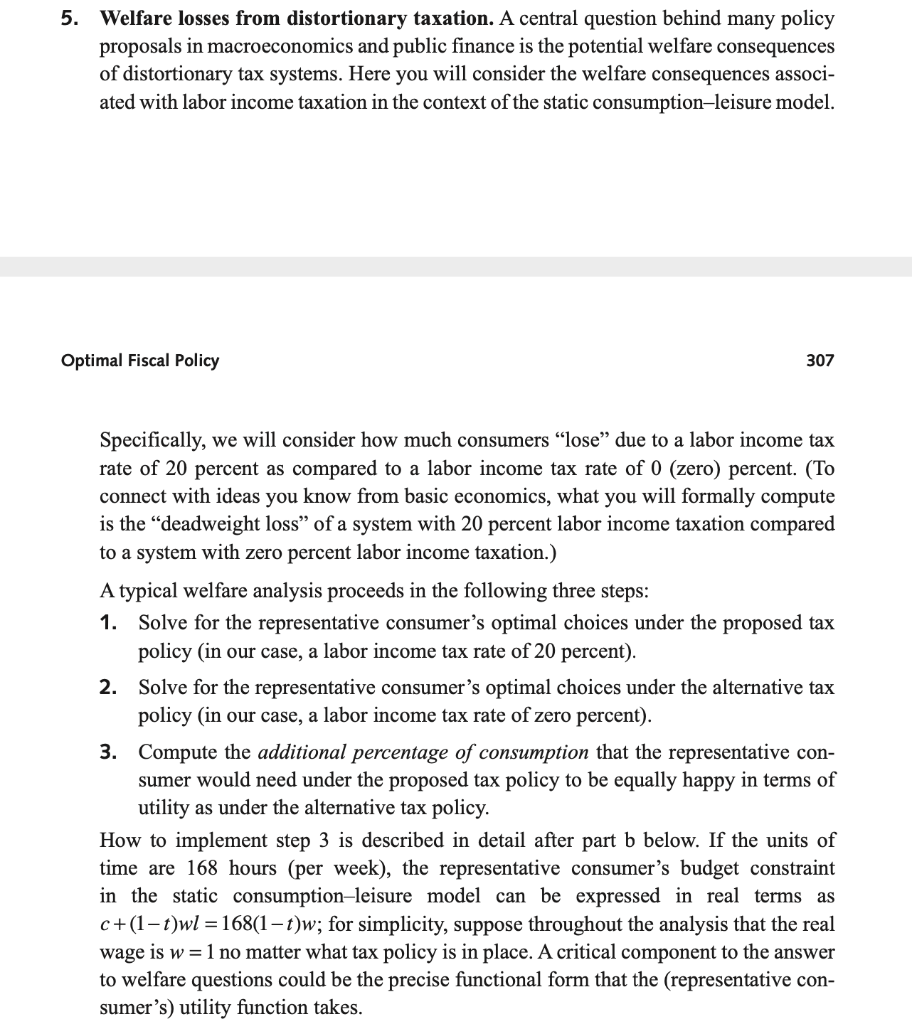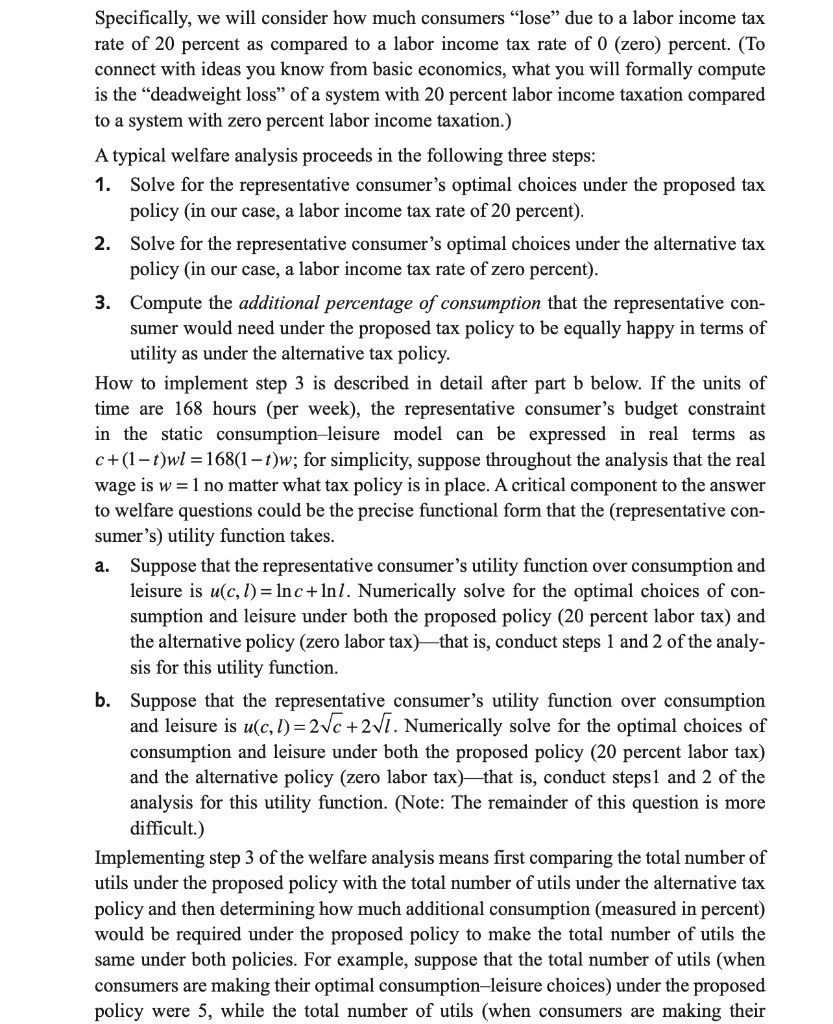

5. Welfare losses from distortionary taxation. A central question behind many policy proposals in macroeconomics and public finance is the potential welfare consequences of distortionary tax systems. Here you will consider the welfare consequences associated with labor income taxation in the context of the static consumption-leisure model. Optimal Fiscal Policy 307 Specifically, we will consider how much consumers "lose" due to a labor income tax rate of 20 percent as compared to a labor income tax rate of 0 (zero) percent. (To connect with ideas you know from basic economics, what you will formally compute is the "deadweight loss" of a system with 20 percent labor income taxation compared to a system with zero percent labor income taxation.) A typical welfare analysis proceeds in the following three steps: 1. Solve for the representative consumer's optimal choices under the proposed tax policy (in our case, a labor income tax rate of 20 percent). 2. Solve for the representative consumer's optimal choices under the alternative tax policy (in our case, a labor income tax rate of zero percent). 3. Compute the additional percentage of consumption that the representative consumer would need under the proposed tax policy to be equally happy in terms of utility as under the alternative tax policy. How to implement step 3 is described in detail after part b below. If the units of time are 168 hours (per week), the representative consumer's budget constraint in the static consumption-leisure model can be expressed in real terms as c+(1t)wl=168(1t)w; for simplicity, suppose throughout the analysis that the real wage is w=1 no matter what tax policy is in place. A critical component to the answer to welfare questions could be the precise functional form that the (representative con- Specifically, we will consider how much consumers "lose" due to a labor income tax rate of 20 percent as compared to a labor income tax rate of 0 (zero) percent. (To connect with ideas you know from basic economics, what you will formally compute is the "deadweight loss" of a system with 20 percent labor income taxation compared to a system with zero percent labor income taxation.) A typical welfare analysis proceeds in the following three steps: 1. Solve for the representative consumer's optimal choices under the proposed tax policy (in our case, a labor income tax rate of 20 percent). 2. Solve for the representative consumer's optimal choices under the alternative tax policy (in our case, a labor income tax rate of zero percent). 3. Compute the additional percentage of consumption that the representative consumer would need under the proposed tax policy to be equally happy in terms of utility as under the alternative tax policy. How to implement step 3 is described in detail after part b below. If the units of time are 168 hours (per week), the representative consumer's budget constraint in the static consumption-leisure model can be expressed in real terms as c+(1t)wl=168(1t)w; for simplicity, suppose throughout the analysis that the real wage is w=1 no matter what tax policy is in place. A critical component to the answer to welfare questions could be the precise functional form that the (representative consumer's) utility function takes. a. Suppose that the representative consumer's utility function over consumption and leisure is u(c,l)=lnc+lnl. Numerically solve for the optimal choices of consumption and leisure under both the proposed policy ( 20 percent labor tax) and the alternative policy (zero labor tax) - that is, conduct steps 1 and 2 of the analysis for this utility function. b. Suppose that the representative consumer's utility function over consumption and leisure is u(c,l)=2c+2l. Numerically solve for the optimal choices of consumption and leisure under both the proposed policy ( 20 percent labor tax) and the alternative policy (zero labor tax) - that is, conduct steps1 and 2 of the analysis for this utility function. (Note: The remainder of this question is more difficult.) Implementing step 3 of the welfare analysis means first comparing the total number of utils under the proposed policy with the total number of utils under the alternative tax policy and then determining how much additional consumption (measured in percent) would be required under the proposed policy to make the total number of utils the same under both policies. For example, suppose that the total number of utils (when consumers are making their optimal consumption-leisure choices) under the proposed policy were 5 , while the total number of utils (when consumers are making their 5. Welfare losses from distortionary taxation. A central question behind many policy proposals in macroeconomics and public finance is the potential welfare consequences of distortionary tax systems. Here you will consider the welfare consequences associated with labor income taxation in the context of the static consumption-leisure model. Optimal Fiscal Policy 307 Specifically, we will consider how much consumers "lose" due to a labor income tax rate of 20 percent as compared to a labor income tax rate of 0 (zero) percent. (To connect with ideas you know from basic economics, what you will formally compute is the "deadweight loss" of a system with 20 percent labor income taxation compared to a system with zero percent labor income taxation.) A typical welfare analysis proceeds in the following three steps: 1. Solve for the representative consumer's optimal choices under the proposed tax policy (in our case, a labor income tax rate of 20 percent). 2. Solve for the representative consumer's optimal choices under the alternative tax policy (in our case, a labor income tax rate of zero percent). 3. Compute the additional percentage of consumption that the representative consumer would need under the proposed tax policy to be equally happy in terms of utility as under the alternative tax policy. How to implement step 3 is described in detail after part b below. If the units of time are 168 hours (per week), the representative consumer's budget constraint in the static consumption-leisure model can be expressed in real terms as c+(1t)wl=168(1t)w; for simplicity, suppose throughout the analysis that the real wage is w=1 no matter what tax policy is in place. A critical component to the answer to welfare questions could be the precise functional form that the (representative con- Specifically, we will consider how much consumers "lose" due to a labor income tax rate of 20 percent as compared to a labor income tax rate of 0 (zero) percent. (To connect with ideas you know from basic economics, what you will formally compute is the "deadweight loss" of a system with 20 percent labor income taxation compared to a system with zero percent labor income taxation.) A typical welfare analysis proceeds in the following three steps: 1. Solve for the representative consumer's optimal choices under the proposed tax policy (in our case, a labor income tax rate of 20 percent). 2. Solve for the representative consumer's optimal choices under the alternative tax policy (in our case, a labor income tax rate of zero percent). 3. Compute the additional percentage of consumption that the representative consumer would need under the proposed tax policy to be equally happy in terms of utility as under the alternative tax policy. How to implement step 3 is described in detail after part b below. If the units of time are 168 hours (per week), the representative consumer's budget constraint in the static consumption-leisure model can be expressed in real terms as c+(1t)wl=168(1t)w; for simplicity, suppose throughout the analysis that the real wage is w=1 no matter what tax policy is in place. A critical component to the answer to welfare questions could be the precise functional form that the (representative consumer's) utility function takes. a. Suppose that the representative consumer's utility function over consumption and leisure is u(c,l)=lnc+lnl. Numerically solve for the optimal choices of consumption and leisure under both the proposed policy ( 20 percent labor tax) and the alternative policy (zero labor tax) - that is, conduct steps 1 and 2 of the analysis for this utility function. b. Suppose that the representative consumer's utility function over consumption and leisure is u(c,l)=2c+2l. Numerically solve for the optimal choices of consumption and leisure under both the proposed policy ( 20 percent labor tax) and the alternative policy (zero labor tax) - that is, conduct steps1 and 2 of the analysis for this utility function. (Note: The remainder of this question is more difficult.) Implementing step 3 of the welfare analysis means first comparing the total number of utils under the proposed policy with the total number of utils under the alternative tax policy and then determining how much additional consumption (measured in percent) would be required under the proposed policy to make the total number of utils the same under both policies. For example, suppose that the total number of utils (when consumers are making their optimal consumption-leisure choices) under the proposed policy were 5 , while the total number of utils (when consumers are making their








